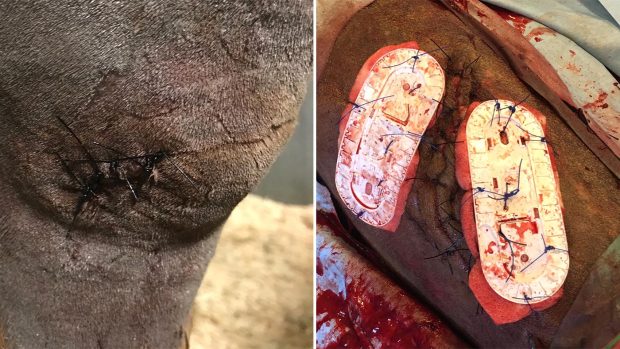A cornered horse will kick out as its prime means of defence, so, if several horses are kept together, kick injuries are inevitable. Where the kick has broken the skin, the type of injury is usually fairly obvious, but if the skin has not been marked, it may be difficult to recognise what has happened.
Kick injuries are localised. You may see little reaction as you feel over the horse’s body, but when you press on the exact spot that was kicked, the horse will respond immediately. Therefore, any examination must be thorough.
Kick injuries are often worse the day after they have occurred. This is the equivalent of a human black eye appearing the day after an injury. Owners often say that their horse was well when they brought it in the previous evening, but after a night in the stable it has suddenly become lame. In many cases, the injury was a kick inflicted the previous day.
If the kick hits a fleshy part of the body, such as the quarters, little, if any, swelling will be visible. If, however, a bony area is kicked, such as the side of the hock, a hard swelling may appear. But even though the lump feels as hard as bone, it is not necessarily a permanent blemish. Initially, these lumps are a fibrous reaction on the bone surface and, as such, they can disappear completely. Only if they persist for about a week will that fibrous tissue become calcified and turn into permanent bone.
Because they are localised injuries, kicks respond best to localised treatment. Cold compresses are the most suitable. They reduce the blood supply to the affected area and so reduce the number of inflammatory cells being brought in – it is these inflammatory cells that cause fluid to leak into the surrounding tissues and cause swelling.The cold compress must be pressed firmly against the area rather than held on the surface. The pressure not only increases the effect of the cold, but also helps prevent further swelling.
Kicks often cause a visible wound. The problem is that a small, insignificant-looking break in the skin may be surrounded by a larger area of inflammation from the kick. You should expect kick wounds to be infected – the foot that caused the wound was in contact with the ground only a second earlier. Expect the wound to be quite deep – the kick compresses all the tissues and punctures through to the deepest extent that the hoof reaches.
Infections usually find it easier to multiply in bruised tissue, so an infected kick wound will incubate infection. When that infection includes anaerobic bacteria, which are able to multiply without oxygen, then the deep puncture wound with only a small surface hole provides ideal conditions.
The best known anaerobe is tetanus. Therefore, it is vital that you keep your horse fully vaccinated, as even the smallest kick wound could prove fatal.
You might also like:

Equine first-aid kit essentials: what you really need
If you're unsure about what you should have in your horse’s first-aid kit, then we are here to help...

The best methods for treating equine wounds
Are you up to date with the latest ideas on wound treatment? Kieran O’Brien MRCVS offers a first-aid refresher

Subscribe to Horse & Hound this spring for great savings
Horse & Hound magazine, out every Thursday, is packed with all the latest news and reports, as well as interviews, specials, nostalgia, vet and training advice. Find how you can enjoy the magazine delivered to your door every week, plus options to upgrade your subscription to access our online service that brings you breaking news and reports as well as other benefits.



